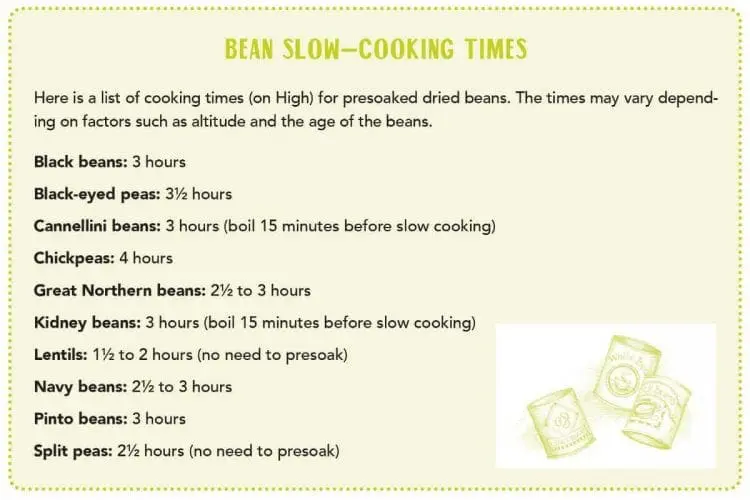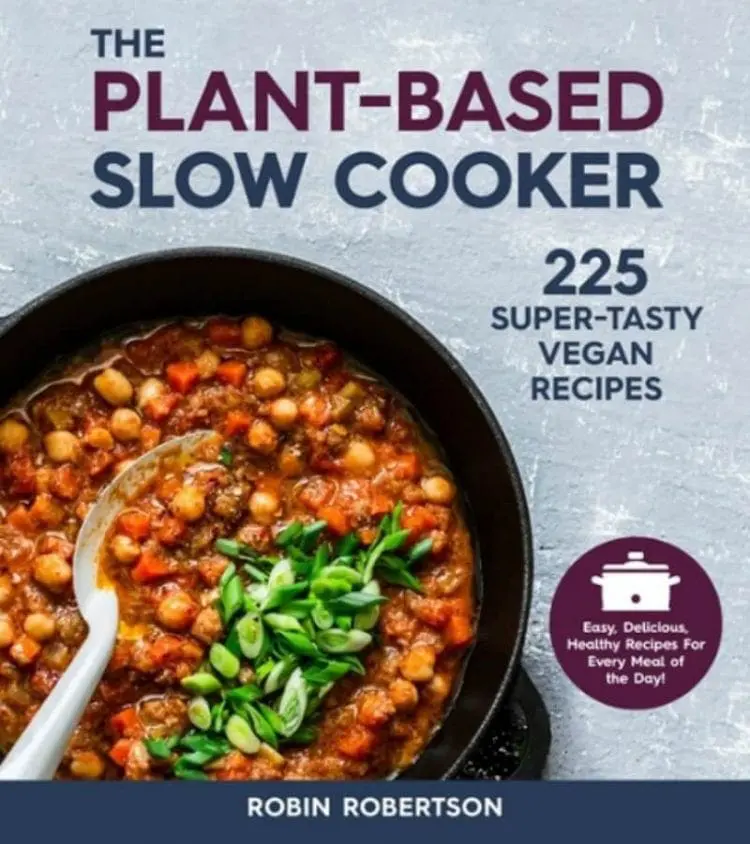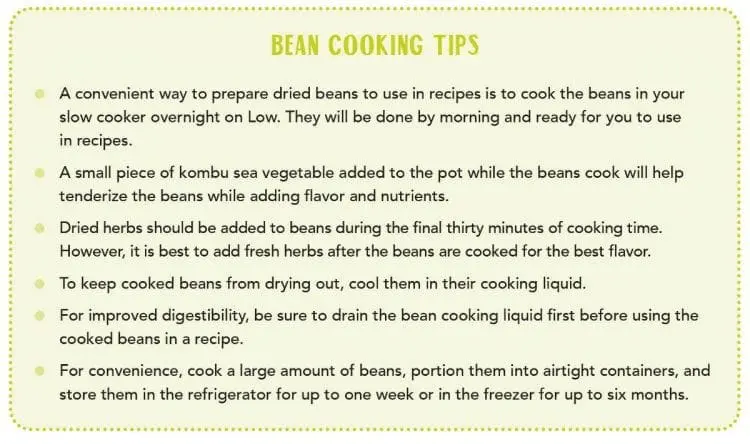Slow cookers are such handy dandy kitchen tools! I just love mine. Slow cookers are the perfect way to cook dried beans from scratch. I love doing this as opposed to buying canned beans for several reasons. Dried beans are so cheap! Cooking dry beans yourself can save you a ton of money. I also like that you can cook exactly how much you want. In this way you are not limited by the can size portions. Finally, it is an easy way to reduce any exposure you may get to metals from cans. Today, cookbook author Robin Robertson is going to share with us how to cook dry beans in a slow cooker.
You can find her latest book hitting bookshelves on November 10th. The Plant-Based Slow Cooker: Over 225 Vegan, Super-Tasty Recipes focuses on extremely convenient, delicious, and completely plant-based recipes for slow cookers. Here is my affiliate amazon link for this amazing cookbook. Besides all the tasty recipes, she also offers a lot of great practical guidance on using slow cookers (aka a crock pot).
Everything You Need To Know About How To Cook Dry Beans In A Slow Cooker

This excerpt is reprinted with exclusive permission. The Plant-Based Slow Cooker: Over 225 Vegan, Super-Tasty Recipes (Revised) Robin Robertson
ISBN: 9781592339907 Harvard Common Press
Wide World of Beans
Because bean cooking was the intended use of the first slow cookers, it almost goes without saying that beans are a natural fit for the slow-cooking method. That said, however, there is a distinction to be made between “cooking beans” and “cooking with beans.” Because beans take longer to cook than most vegetables, I prefer to use beans that have already been cooked in most of my recipes. This is to avoid overcooking the vegetables. Another reason for using precooked beans in recipes is that it allows me to drain off the cooking liquid after cooking beans, making them more digestible.
In chapter 5, you will find a recipe for Basic Beans (page 114), along with variations. Cooking beans from the dried state in the slow cooker is both easy and economical. I like to cook large batches of different kinds of beans, portion them into containers, and freeze them to use later in recipes. If you prefer your beans firm rather than soft, you can slow cook your beans until they are just tender but still quite firm. Then allow them to cook the rest of the way in the various recipes you will be using them in.
While many of us enjoy cooking a variety of different beans, it’s a safe bet that most of us have barely scratched the surface in terms of what types are available. Believe it or not, there are more than 13,000 different beans and legumes in the world. That’s a lot of beans!

BEAN COOKING Guidelines
There are some general guidelines to follow when cooking beans in a slow cooker. Bear in mind that dried beans expand when soaked and cooked. One cup of dried beans (weight varies) yields 2 to 3 cups (weight varies) cooked.
As a rule, you can cook 1 cup (weight varies) of presoaked beans in 4 cups (960 ml) of fresh water. You should use 6 cups (1.4 L) of water for 2 cups (weight varies) of presoaked beans. For 1 pound (455 g) of dried beans, you will need 8 to 10 cups (1.9 to 2.4 L) of water. The beans should stay submerged in the water while cooking. Therefore, you should check on them about 1 hour before they are scheduled to be done. Add some boiling water if needed. Otherwise, the beans that are not submerged may still be hard when the cooking time is over. Once cooked, the beans should cool in the slow cooker in their own liquid. You can then transfer the cooked beans into 1-to 2-cup (240 to 480 ml) containers, using a slotted spoon, then refrigerate or freeze until needed.
Most beans are done cooking in a slow cooker after three to four hours on High or eight to ten hours on Low. Although some may take longer depending on the age and variety of bean, others are done much sooner. With the exception of lentils and split peas, which do not require soaking, beans benefit from presoaking. This helps shorten the cooking time and makes them more digestible.
Special Note On Kidney Beans
Note that uncooked kidney beans (including cannellini beans which are white kidney beans) contain a natural toxin (lectin phytohaemagglutinin) that must be destroyed by cooking. To do this, it is very important that you boil raw kidney beans in water for at least ten to fifteen minutes before cooking in the slow cooker. This is because the temperature of slow cooking alone may not be hot enough to destroy the toxin.
Bean Ratios
You may sometimes want to make a recipe using cooked beans but you don’t happen to have any stashed in the freezer, and there’s no time to cook them from scratch. In those instances, let canned beans come to the rescue. This is another reason most recipes call for“cooked” beans—allowing you the choice of using cooked-from-scratch beans or canned beans. When a recipe calls for 1 1/2 cups (425 g) of cooked beans, for example, you can use one 15-ounce (425 g) can of drained beans. Use two cans of beans when a recipe calls for 3 cups (750 g), and so on.
Here are some general ratios of dried, cooked, and canned beans to help you plan:
● 1 pound (455 g) dried beans = 2 cups(455 g) dried beans = 6 cups (1.5 kg)cooked beans = 4 (15-ounce, or 425 g). cans of beans
● 1/2 cup (125 g) dried beans = 1 1/2 cups(425 g) cooked beans = 1 (15-ounce,or 425 g) can of beans

HOW TO SALT-SOAK BEANS
In recent years, many cooks have become enlightened about the relationship between beans and salt. Despite previous convictions to the contrary, it is now thought that “salt-soaking” your beans before cooking can actually help the beans cook faster.
Quick method: In a large pot or heatproof bowl, combine 1 pound (455 g) dried beans (rinsed and picked over), 2 tablespoons (36 g) salt, and 2 quarts (1.8 L) boiling water. Stir to dissolve the salt. Set aside at room temperature for one hour, then drain the beans, discard the soaking liquid, and rinse the beans before cooking.
Overnight method: In a large pot or bowl, combine 1 pound (455 g) dried beans (rinsed and picked over), 2 tablespoons (36 g) salt, and 4 quarts (3.8 L) cold water, stirring to dissolve the salt. Cover and set aside at room temperature for eight hours, then drain the beans, discard the soaking liquid, and rinse the beans before cooking.

Basic Beans Slow Cooker Recipe
MAKES 6 TO 7 CUPS (1 KG TO 1.2 KG)
SLOW COOKER SIZE: 4-TO 6-QUART (3.8 TO 5.7 L)
COOK TIME: 6 TO 8 HOURS ON HIGH
GLUTEN-FREE |OIL-FREE | SOY-FREE
This is a basic recipe for slow cooking dried beans such as pintos, kidneys, cannellinis, chickpeas, black-eyed peas, and great northern beans. To add some flavor to the beans, include the optional onion, garlic, and bay leaves. If you prefer them unseasoned, just cook them in clean water. Then you will have beans that are ready to use in any kind of recipe calling for cooked beans.
- 1 pound (455 g) dried beans, rinsed and picked over
- 1 large yellow onion, quartered (optional)
- 2 garlic cloves, crushed (optional)
- 2 bay leaves (optional)
1. Salt-soak the beans according to one of the methods described on page 30.
2. Place the beans in the slow cooker. (If cooking kidney beans or cannellini beans, boil them for 10 minutes on top of the stove before adding to the slow cooker.) Add the onion, garlic, and bay leaves (if using), and enough water to cover. Cover and cook on High until tender, 6 to 8 hours, depending on the type of bean.
Conclusion
Cooking dry beans in a slow cooker is a simple, hands-off method that delivers tender, flavorful results with minimal effort. By soaking the beans (if desired), rinsing them thoroughly, and cooking them on low for 6 to 8 hours with enough liquid and seasonings, you can enjoy a nutritious, budget-friendly addition to your meals. This method is not only convenient but also enhances the natural taste and texture of the beans. They are a reliable staple for a variety of dishes.
Again, I am very thankful to Robin Robinson and the Harvard Common Press for sharing this excerpt from her new book, The Plant-Based Slow-Cooker. I think she provided a great guide to how to cook dry beans in a slow cooker! Beans are a healthy choice and a great way to increase plant-based protein in your diet. They are also an economical way of getting your protein fix. Plus, you may be surprised how this old fashioned way to cook beans really brings out their natural flavors!
Related Posts:

Robin Adam says
Wow! Thanks for sharing such an informative blog about “HOW TO SALT-SOAK BEANS”. This was a delicious dry bean recipe and i like it very much. I’ve always been a bit unsure about cooking dry beans, but your step-by-step tips make it feel totally doable. Worked great in my slow cooker.
Laura Harrison says
I grew a variety of beans this summer. I got busy and let most stay on the vine so shelled them for use as dry beans. When shelling and bagging then, I mixed them all together.
I guess I will have to boil them first b/c they have a few kidneys mixed in.
I never knew that so thank you for the article.
MH says
Great article! We really enjoyed reading about how simple and cost-effective it can be to cook dry beans in a slow cooker. The detailed soaking and cooking tips make it so easy for anyone to try. Saving time and money in the kitchen is important.